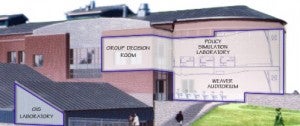Facilities
 The Policy Simulation Complex is a group of electronically networked rooms that capitalize on emerging technologies to help policy makers and other interested parties better understand the consequences of actions.
The Policy Simulation Complex is a group of electronically networked rooms that capitalize on emerging technologies to help policy makers and other interested parties better understand the consequences of actions.
What makes this facility unique is the close integration of the various system components to create a flexible, coordinated facility for studying decision making, and for helping communities to visualize the consequences of policy actions. All of the rooms are linked through the use of computer networks, so we can harness the power of modern technology to help communities make better decisions.
The Policy Simulation Laboratory Complex is made up of the SimLab, two Group Decision Rooms, a Presentation Hall and a Large Conference room. The SimLab is a computer lab with 26 computer workstations and advanced audio-visual capabilities. The Group Decision Rooms are small conference rooms that seat up to 12 people who make decisions while interacting face-to-face. The Presentation Hall is a 125 seat auditorium with advanced audio-visual aids and in-seat voting capabilities.
For example, the town council in one of the Group Decision Rooms might design a plan for managing growth in the town. Computer systems in the Policy Simulation Complex simulate the environmental, economic and social consequences policies to manage growth in a community. Geographic Information Systems use electronic maps to present the consequences of policies for the town.
We use tools like digital imagery and virtual reality to depict policy related changes. For example, we can create a virtual drive through a proposed development, or a virtual flyby of the community, so that interested parties can better visualize the consequences of growth management policies on the character of the community.
Researchers also use the System to carry out frontier work using methods of experimental economics to study behavior of individuals and groups. This extends our understanding of how choices are made, and how decision making processes respond to changes in the decision environment. For example, we can study how the design of markets affect the power of buyers and sellers, or how complexity and uncertainty affect decisions.
In summary, the Policy Simulation Laboratory provides a flexible integrated venue to study decision making, and for applying technology-based tools to improve our ability to make wise choices.
 Home
Home Browse
Browse Close
Close Events
Events Maps
Maps Email
Email Brightspace
Brightspace eCampus
eCampus


